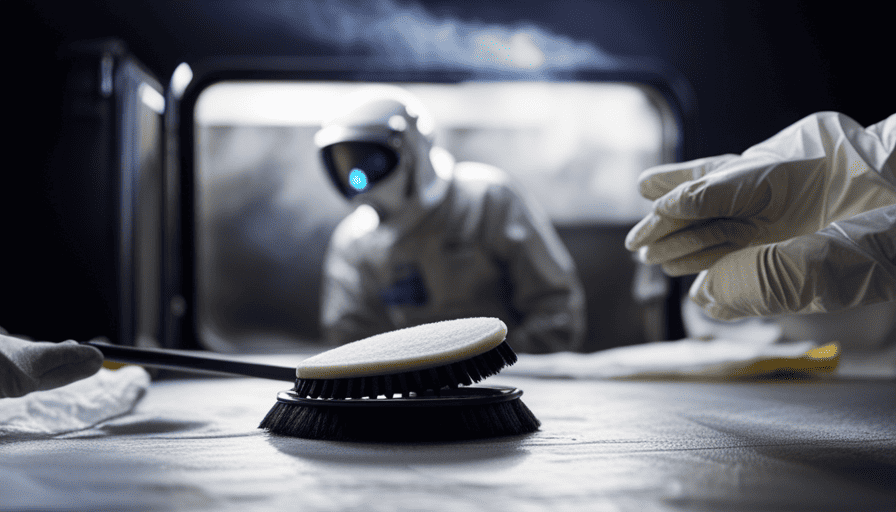Are you prepared to set out and begin an adventure in your camper trailer? Before you head out, it’s essential to check that your canvas is clean and mold-free. Mold can damage the look of your camper trailer and also present health hazards to you and your loved ones.
But fear not, because I’ve got you covered with a step-by-step guide on how to clean mould off camper trailer canvas. From assessing the extent of the mould infestation to applying a waterproofing treatment, I’ll walk you through each and every detail to ensure that your canvas is spotless and ready for your next journey.
So let’s get started and get that mould out of your way, so you can enjoy your camper trailer to the fullest!
Key Takeaways
- Cleaning mould off camper trailer canvas is important for maintaining its condition and preventing potential health risks.
- The process involves assessing the extent of mould infestation, gathering necessary cleaning supplies, and mixing a vinegar and water solution to break down mould spores.
- Thoroughly scrubbing the affected areas with the solution and rinsing the canvas with clean water are crucial steps.
- Allowing the canvas to air dry completely and applying a waterproofing treatment can help prevent future mould growth.
Assess the Extent of the Mould Infestation
Take a close look at the camper trailer canvas to see just how much mould has invaded. Assessing the extent of the mould infestation is crucial in determining the appropriate cleaning method.
Not only is it important for maintaining the appearance of the canvas, but also for assessing any potential health risks associated with mould. Mould can cause respiratory issues and allergies, so it’s essential to take this step seriously.
Start by inspecting the surface of the canvas thoroughly. Look for visible signs of mould, such as black or green patches. Pay attention to any musty odor, as it can indicate a more significant mould problem. Additionally, check for any discoloration or staining on the canvas.
To prevent future mould growth, it’s important to identify the source of moisture. Inspect the camper trailer for any leaks or areas where water can enter. Fixing these issues can help prevent mould from returning after cleaning.
Now that you’ve assessed the extent of the mould infestation and identified potential health risks and sources of moisture, it’s time to gather the necessary cleaning supplies.
Gather the Necessary Cleaning Supplies
Make sure you’ve got all the essential tools at your disposal before tackling the task of banishing that pesky fungi from your camper’s fabric. Choosing the right cleaning supplies is crucial to effectively remove mold from your trailer canvas. Start by gathering a soft brush or sponge, mild detergent, vinegar, water, and a bucket. These supplies will help you tackle the mold without causing any damage to the fabric.
To begin the cleaning process, mix a solution of one part vinegar to three parts water in the bucket. Vinegar is a natural mold killer and will help break down the mold spores. Dip the brush or sponge into the solution and gently scrub the affected areas. Be sure to cover all the mold-infested spots thoroughly. Pay extra attention to seams and corners where mold tends to accumulate.
Proper cleaning techniques are essential to ensure the mold is completely eradicated. After scrubbing the canvas, rinse it thoroughly with clean water to remove any remaining vinegar solution. This step is crucial as leaving vinegar on the fabric can cause discoloration. Once rinsed, allow the canvas to air dry completely before moving on to the next step.
Now that we’ve gathered our cleaning supplies and properly scrubbed the mold-infested areas, it’s time to remove loose debris and dust from the canvas.
Remove Loose Debris and Dust from the Canvas
Once you’ve gathered all the necessary supplies, it’s time to ensure that any loose debris and dust are effectively removed from the fabric of your camper. Cleaning the canvas thoroughly is essential to prevent further mold growth and maintain the longevity of your camper. Here are some cleaning techniques and preventative measures you can take:
-
Start by using a soft-bristled brush or a broom to gently sweep away any loose debris, such as leaves, dirt, or twigs. Be careful not to apply too much pressure to avoid damaging the fabric.
-
Next, use a handheld vacuum cleaner with a brush attachment to remove any remaining dust from the canvas. Make sure to cover all areas, including corners and seams, to ensure a thorough cleaning.
-
For stubborn dirt or stains, you can use a mild detergent mixed with warm water. Dip a soft cloth or sponge into the solution and gently scrub the affected areas. Avoid using harsh chemicals or bleach, as they can damage the fabric.
-
Rinse the canvas with clean water using a hose or a spray bottle. Make sure to remove any soap residue thoroughly.
-
Finally, allow the canvas to air dry completely before proceeding to the next step.
By following these cleaning techniques and taking preventative measures, you can effectively remove loose debris and dust from your camper’s canvas. Once the canvas is clean, it’s time to move on to creating a cleaning solution to tackle the mold problem.
Create a Cleaning Solution
To easily tackle the mold problem on your camper’s fabric, mix up a cleaning solution that will leave your canvas looking fresh and smelling great. The cleaning process involves creating a solution using common household ingredients. Here is a simple recipe for an effective cleaning solution:
| Ingredient | Measurement | Purpose |
|---|---|---|
| Distilled white vinegar | 1 cup | Removes mold and mildew |
| Warm water | 2 cups | Dilutes the vinegar and aids in cleaning |
| Tea tree oil | 1 teaspoon | Acts as a natural disinfectant |
In a bucket or spray bottle, combine the vinegar, warm water, and tea tree oil. Mix well until the solution is thoroughly blended. The vinegar will help eliminate mold and mildew, while the tea tree oil will provide additional antibacterial properties. The warm water helps to dilute the vinegar and aids in the cleaning process.
Once you have your cleaning solution ready, you can move on to the next step and test it on a small area of your camper’s canvas to ensure it does not cause any damage. This will help you determine if the solution is safe to use on the entire surface of your camper trailer.
Test the Cleaning Solution on a Small Area
Before applying the solution, it’s crucial to see the incredible results and make sure it won’t harm the precious fabric. The best way to do this is by testing the cleaning solution’s effectiveness on a small area. Here’s how to test the solution before using it on the entire camper trailer canvas:
- Choose a small, inconspicuous area on the canvas to test the solution.nn2. Dilute the cleaning solution according to the instructions.nn3. Apply a small amount of the solution to the chosen area using a clean cloth or sponge.nn4. Gently scrub the area in circular motions to work the solution into the fabric.
After testing the solution, check for any discoloration or damage to the fabric. If the solution passes the test and effectively removes the mold without causing harm, you can proceed with confidence. However, if there are any negative effects, it’s important to consider alternative cleaning methods.
Now that we’ve ensured the safety and effectiveness of the cleaning solution, let’s move on to applying it to the moldy areas of the camper trailer canvas.
Apply the Cleaning Solution to the Mouldy Areas
Now that we’ve tested the cleaning solution and seen its incredible results, it’s time to banish the stubborn mold from the fabric with its powerful formula. Applying the cleaning solution is a crucial step in effectively cleaning the camper trailer canvas.
Start by pouring the solution into a spray bottle for easy application. Make sure to shake the bottle well to ensure the solution is properly mixed. Then, spray the cleaning solution onto the moldy areas of the canvas, ensuring complete coverage. The solution will work to break down the mold and remove any stains or discoloration.
When applying the cleaning solution, it’s important to use a thorough and methodical technique. Start from the top and work your way down, ensuring that each section is evenly coated. Use a gentle, circular motion to rub the solution into the fabric, paying extra attention to any particularly moldy spots. Allow the cleaning solution to sit on the canvas for a few minutes to allow it to penetrate and break down the mold.
To transition into the subsequent section about scrubbing the canvas gently with a soft brush, we can move on to the next step of the cleaning process.
Scrub the Canvas Gently with a Soft Brush
Once the cleaning solution has had time to penetrate the fabric and break down the mold, I gently scrub the canvas with a soft brush to remove any remaining traces. The soft brush is essential in this step as it helps to dislodge the mold without causing any damage to the canvas.
To give you a better understanding of how to scrub the canvas effectively, let me provide you with a table that outlines the process:
| Step | Action | Tips |
|---|---|---|
| 1 | Dip the soft brush into the cleaning solution | Make sure the brush is adequately soaked in the solution to maximize its cleaning power. |
| 2 | Apply gentle pressure and scrub in circular motions | Avoid using excessive force to prevent any tears or damage to the canvas. |
| 3 | Focus on the moldy areas | Concentrate your efforts on the parts of the canvas that are visibly affected by mold. |
| 4 | Rinse the brush regularly | Rinse the brush in clean water to remove any mold particles that may have accumulated. |
Once the canvas has been scrubbed thoroughly with the soft brush, it is time to move on to the next step: rinsing the canvas thoroughly. This will ensure that all traces of the cleaning solution and mold are completely removed.
Rinse the Canvas Thoroughly
To ensure a pristine and mold-free surface, it’s crucial for you to thoroughly rinse the canvas after scrubbing it with a soft brush. This step is an essential part of canvas maintenance and plays a vital role in preventing mold growth.
When rinsing the canvas, make sure to use a gentle stream of water. Start at the top and work your way down, ensuring that all the soap residue and loosened mold particles are completely washed away. Pay extra attention to the corners and seams, as these areas are prone to mold buildup.
To emphasize the importance of thorough rinsing, consider the following sub-lists:
-
Benefits of thorough rinsing:
- Removes any remaining soap residue that can attract mold spores.
- Ensures that all loosened mold particles are completely washed away.
-
Tips for effective rinsing:
- Use a gentle stream of water to avoid damaging the canvas.
- Start at the top and work your way down to ensure complete coverage.
- Pay extra attention to corners and seams, as mold tends to accumulate in these areas.
After rinsing, allow the canvas to dry completely. This will help prevent any residual moisture from promoting mold growth.
Moving on to the next step, which is allowing the canvas to dry completely, it’s important to follow a few guidelines to ensure optimal results.
Allow the Canvas to Dry Completely
Make sure you give the canvas ample time to dry completely, allowing the warm sun to gently penetrate the fabric and evaporate any lingering moisture. The drying process is crucial in preventing moisture from getting trapped in the canvas, as this can lead to the growth of mold and mildew. After rinsing the canvas thoroughly, it’s important to let it air dry in a well-ventilated area. Hang the canvas in a place where it can receive plenty of sunlight and fresh air. This will help to kill any remaining mold spores and prevent them from regrowing.
It’s recommended to leave the canvas outside for at least 24 hours, or until it feels completely dry to the touch. This will ensure that all moisture has evaporated from the fabric. After the canvas has dried completely, you can move on to the next step of applying a waterproofing treatment to prevent future mold growth.
Apply a Waterproofing Treatment to Prevent Future Mould Growth
Ensure your canvas stays protected by applying a waterproofing treatment that will effectively prevent any future mold growth. Waterproofing techniques are essential for maintaining the longevity and durability of your camper trailer canvas. By taking the necessary steps to prevent mold growth, you can prolong the life of your canvas and ensure a pleasant camping experience.
To begin, choose a waterproofing treatment specifically designed for canvas materials. These treatments are readily available at outdoor supply stores or online. Follow the instructions provided by the manufacturer for the best results.
Before applying the treatment, it’s important to thoroughly clean the canvas and allow it to dry completely.
Once the canvas is clean and dry, evenly apply the waterproofing treatment using a soft brush or sponge. Make sure to cover the entire surface, paying extra attention to seams and areas prone to moisture. Allow the treatment to dry completely before using the canvas again.
Regularly inspect the canvas for signs of wear or damage, and reapply the waterproofing treatment as needed. It’s also recommended to store the canvas in a dry and well-ventilated area when not in use to prevent mold growth.
By incorporating these waterproofing techniques into your camper trailer maintenance routine, you can effectively prevent future mold growth and ensure that your canvas remains in optimal condition for years to come.
Frequently Asked Questions
How often should I clean my camper trailer canvas to prevent mould growth?
Cleaning your camper trailer canvas regularly is essential to prevent mould growth. Did you know that 80% of camper trailer owners experience mould issues due to infrequent cleaning?
To keep your canvas mould-free, it’s recommended to clean it every 3-4 months, or more frequently if you frequently camp in humid or rainy areas. Here are some tips to prevent mould:
- Regularly brush off dirt and debris.
- Store your camper in a dry environment.
- Consider using a waterproof cover.
Can I use bleach to clean mould off my camper trailer canvas?
Yes, bleach can effectively remove mould from camper trailer canvas. However, there are also bleach alternatives and natural cleaning solutions that can be used.
Bleach alternatives such as hydrogen peroxide or vinegar mixed with water can be just as effective in killing mould spores. Natural cleaning solutions like tea tree oil or grapefruit seed extract are also known for their mould-fighting properties.
These alternatives provide a safer and more eco-friendly option for cleaning mould off your camper trailer canvas.
Is it safe to use a pressure washer to rinse off the cleaning solution from the canvas?
Sure, using a pressure washer to rinse off the cleaning solution from the canvas can be safe if it’s done properly. However, it’s important to exercise caution to avoid damaging the canvas. Use a low-pressure setting and keep the nozzle at a distance to prevent tearing or stretching.
Alternatively, you can consider using a soft brush or sponge to gently remove the cleaning solution. Remember, safety should always be a priority when using a pressure washer or exploring alternative cleaning methods.
Can I apply the waterproofing treatment before the canvas is completely dry?
Yes, it’s generally recommended to wait until the canvas is completely dry before applying the waterproofing treatment. This ensures that the treatment can penetrate the fabric effectively and provide maximum protection against water damage. However, it’s important to follow the specific instructions provided by the waterproofing product manufacturer, as some treatments may have different application requirements. In general, it’s best to prioritize thorough cleaning and drying before proceeding with the waterproofing treatment process to ensure optimal results and longevity of the canvas.
What should I do if the mould infestation is too severe and cannot be completely removed?
If the mould infestation on your camper trailer canvas is too severe and cannot be completely removed, there are alternative cleaning methods you can try.
One option is to use a mixture of vinegar and water to scrub the affected areas.
Another option is to use a commercial mould remover specifically designed for canvas.
However, if these methods are unsuccessful, it may be necessary to seek professional mould removal services to ensure the problem is properly addressed.
Will Cleaning Mould Off the Camper Trailer Canvas Also Clean the Inside of the Trailer?
Cleaning mould off the camper trailer canvas is essential for maintaining its longevity and appearance. However, it is important to note that this process does not automatically clean the inside of the trailer. To ensure a thorough cleaning, a separate effort is required for cleaning the inside of a camper. Regular cleaning routines will contribute to a fresher and more comfortable camping experience overall.
Conclusion
In conclusion, cleaning mould off your camper trailer canvas isn’t just important for aesthetic reasons, but also for the health and longevity of your trailer. By following the steps outlined in this article, you can effectively remove mould and prevent future growth.
Remember, prevention is key, so be sure to regularly inspect and clean your canvas to avoid any potential infestations. With a little time and effort, your camper trailer will be mould-free and ready for your next adventure.
So, don’t let mould dampen your spirits. Take action and keep your camper canvas clean and safe for years to come.










